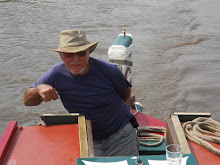Wednesday 3rd
August.
Back On The Cut.
I knocked up the
guy moored in front once again and he answered this time. It appeared that he
too was keen for some company to do all eleven movable bridges. The first two
where done for us, but the remainder had to be done by the boater. They were
all waterway key operated, but some had to be manually opened. We did then
alternately, so in all I only opened about five in the fifteen mile length to
the junction. Trevor was a continuous cruiser on nb Wyrd, although his wife
lived in Crawley, Sussex. Before we let go at Keadby, he insisted on telling me
his life story and it was only by interrupting at an opportune moment that we
got away at all.
The first bridge
was a busy railway crossing on a sliding bridge that appears to be unique and
details of it’s operation can be found here:-
This view is looking along the track. The bridge has been moved
to one side and has been slid alongside the track on the left.
The duckweed piles up against the mooring.
It was an extremely
windy day, which made the trip unpleasant, because it was either in my face or
from the side, which made getting the boat off the bridge landings difficult.
After struggling at one bridge, I discovered after half a mile that I had left
my keys in the operating pedestal, so had to wind the boat and return for them.
Eventually, Trevor
and I parted at Stainforth, where there were moorings outside The New Inn, a
very well kept free house. Whilst there, a lady approached me from the bar and
asked if I was the person from the Wey Navigation and we got into conversation
about my home mooring, as she knew the navigation very well from several years
ago. She introduced her husband and invited me to moor outside her house at
Barnby Dun if I wished and even invited me for a meal, to which I declined as I
was turning north at the next junction. How’s that for Yorkshire hospitality?
Thursday 4th
August.
Another couple were
going the same way today, so agreed to travel together, because there were
several locks and even more swing and lift bridges. Their daughter was with
them and enjoyed operating the bridges and locks, the latter all being electric
as well.
The New Junction
Canal ran dead straight for five miles, so there was little of interest to see
until we arrived at Southfield Junction and turned onto the Aire and Calder
Canal, which was also pretty monotonous.
Straight as a die for miles.
Guillotine stop gates at River Don Aqueduct.
Once again the wind was persistently
in my face or from one side, making for a rather unpleasant journey under
overcast skies. It appeared that the only decent pub on route was closed when
we passed by, so we finally moored up just before Whitely Lock, where there was
grass for Paul’s dogs to enjoy and that is when the sun finally made an
appearance.
Along this route, I
noticed several boxes mounted on poles at the waterside and was very curious to
know what they were for. Having taken a long lens photo of one of them, I later
looked them up and found this:-
http://www.wlma.org.uk/uploads/WMA_Operation_Barn_Owl.pdf So that is what they are for!
Just what are these?
The label is the clue.







No comments:
Post a Comment